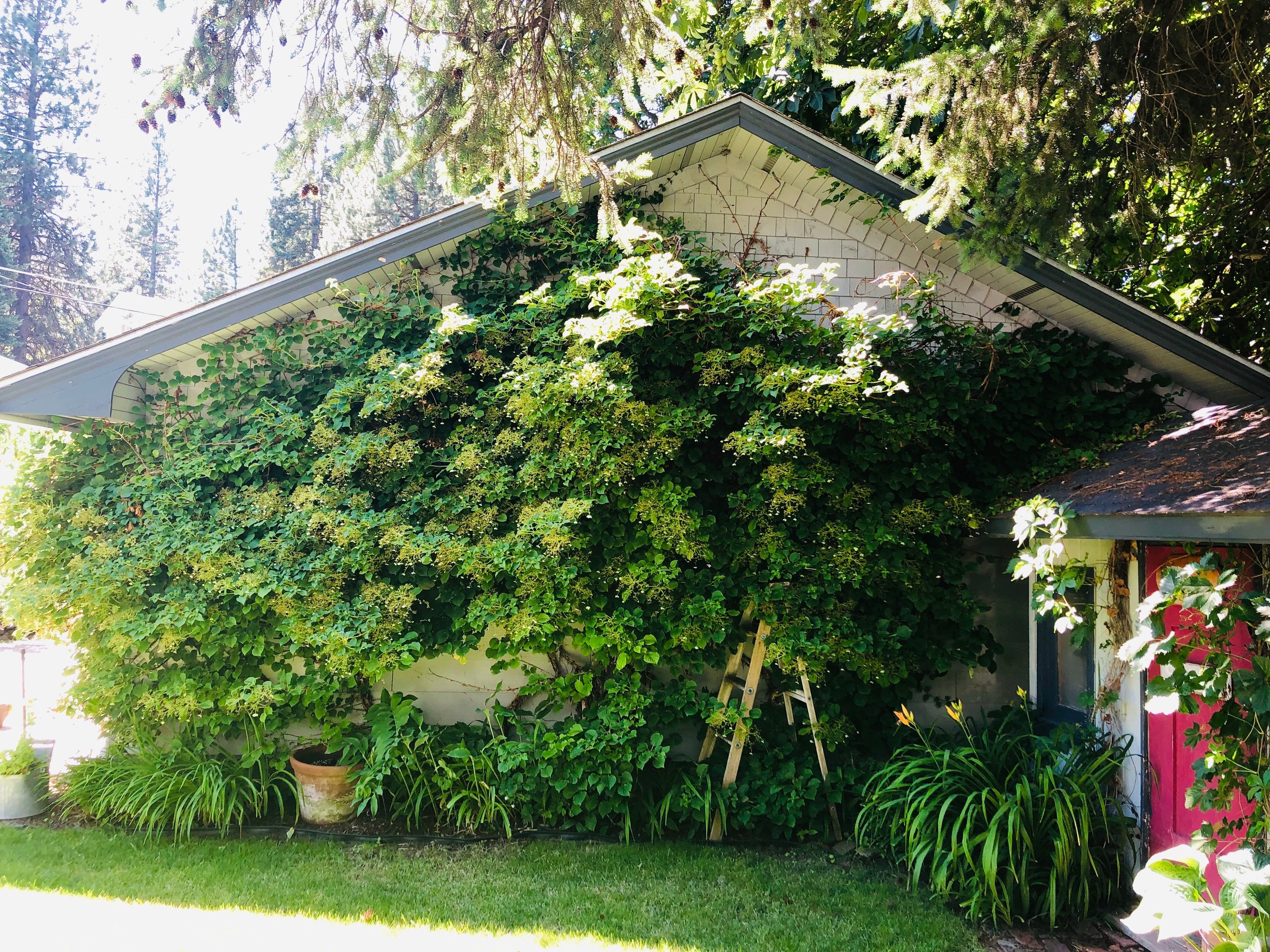Here’s a list of the most common climbing plants and where and when to plant them.
Jasmine
(Oleaceae)
Jasmine are the perfect climbing plant, as far as I’m concerned. They don’t cling or ruin siding, they are easy to prune, their flowers are gorgeous and emit a lovely fragrance. They’re evergreen, quick growing and they’re aren’t aggressive or invasive. We planted them on our privacy trellis, but you could plant them anywhere. They like a bit of shade, but could really thrive just about anywhere. Definitely recommend this vine.
Wisteria
(Papilionaceae)
Wisteria isn’t my favorite. I get the excitement over it, especially from people who live in climates where it won’t grow. The purple flowers are beautiful. For some reason the leaves on wisteria really bother me. I just don’t like them. I don’t love how the plant looks when it’s flowering, the flowers seem washed out for some reason. There are a few reasons we removed the one that was originally on our house and why we didn’t plant this on our backyard trellis. But, if you love then don’t be deterred by my opinions, but be prepared to care for it properly.
It’s woody and commonly pulls down trellises or walls, rain gutters, siding, whatever it can grab on to. The 30-year-old wisteria we removed from our house had a trunk that was nearly 12 inches in diameter (the stump is still there) and had to be removed by a professional because the arbor it was on was rotted and compromised.
It’s a wrapping vine, meaning it weaves around things rather than clinging. So while it won’t necessarily damage grout or paint, it is very strong. Proper and regular maintenance is required to keep it looking the photo above.
It’s deciduous and not evergreen. It loses it leaves in the fall and they don’t grow back until after it flowers and we wanted year round color.
It can be aggressive. It will grow well beyond what you planned for it (if you don’t manage and prune it), but it’s not hard to control. And again, it can get very heavy, so I recommend planting it on iron fences or concrete walls, but not wood structures. Regular pruning can help it produce more flowers and leaves across the entire plant and guide the direction of its growth. It’s not a super fast-growing plant, so that makes it a big more manageable to maintain.
It needs full sun to thrive! Most climbing plants can thrive in shade, but wisteria is not one of those. Like most plants, it will seek out sunlight, if there isn’t enough in the spot where you’ve planted it, it will try to get to where sun is and not grow as many leaves or flowers in the parts that don’t get enough sunlight.
Trumpet Vine
(Campsis)
I love trumpet vine, but we aren’t going to plant this for the same reasons we won’t grow wisteria.
Trumpet vine is invasive, meaning it will drop seeds that will grow more trumpet vines.
It climbs by shooting aerial roots into structures. This can damage structures and cause additional damage and make it difficult to remove without causing structural damage. I did some googling and Southern Living has an article about why not to plant this. Obviously, certain plants can be more aggressive and prolific in different climates, and trumpet vine probably isn’t so crazy in drier climates, but definitely think long and hard before planting it.
Pollinators love trumpet vine flowers, in the summer you will attract hummingbirds (yay) and lots and lots of bees (eek).
Trumpet vine grows very fast and needs to be pruned aggressively.
Clematis
(Ranunculaceae)
Clematis is a great, non-clinging, shade-loving, flowering, climber. We have some in the front yard, and I love it. There are tons of varieties (even some that are evergreen. The like some shade/some sun and produce gorgeous flowers. In my experience, they aren’t aggressive. They like to have some kind of help with climbing, like chicken wire or some kind of mesh behind them. They’ll wrap around other structures, but if they’re too thick, Clematis can be kind of lazy. I transplanted one that must have been planted years ago in the front yard and never really thrived and it’s doing so well. I water it, but don’t do much else to care for it. We may end up adding these to our trellis to have a little extra color in there.
When pruning clematis, ensure that you prune to encourage growth at the bottom, like many plants if you let them get too woody at the bottom, they won’t produce leaves or flowers there anymore.
There are a ton of great resources on clematis including a gorgeous garden here in Portland, Oregon and an International Clematis Society (don’t let the old website deter you!) with local chapters you can join.
Climbing Hydrangea
Photo by my sister! This is my parent’s garage and hands down the most perfect and beautiful climbing hydrangea I’ve ever seen.
This is one of my all-time favorite plants. Climbing hydrangeas love shade, are hardy, there are evergreen varieties and while they cling, they won’t damage the exterior of your house like ivy or wisteria. We planted some on the back side of our garage, and I cannot wait to watch it grow. They grow relatively slowly, but are very easy to maintain. They cling, but won’t damage your walls. If you want to remove them, you need to cut the vine, wait for it to die and then it will detach from the wall.
Ivy
There are several different types of ivy. Boston ivy, English ivy, poison ivy….Ivy is everywhere and can be invasive if it’s left alone. But there is a time and a place for ivy. It’s great for large properties, especially those on hills. It can help prevent erosion and fill large spaces quickly, it can grow pretty much anywhere. It’s hard to kill and will continue to come back until the end of time. I wouldn’t plant it in my yard, but we have a small, urban lot. It is a clinger, so can damage grout on brick houses and crawl up and under wood and vinyl siding. But if you have a really ugly wall and the only thing that will grow there is ivy. Go for it! It’s evergreen, some have great fall color and it grows very fast, so can quickly cover up a wall or yard.
You shouldn’t let ivy grow on your tree roots or up your trees. Ivy can strangle your trees and prevent moisture from dispersing from roots causing hard-to-detect root rot.
Fruit Vines (Kiwi, Grapes, etc.)
There are fruit-bearing and decorative grape vines. Kiwi vines (even hardy vines) can be fun too! If you’re interested in growing these for fruit, then definitely consult experts, folks at your nursery may be able to direct you to the right people or information. Kiwi are kind of cool, but somewhat slow growing, if you plant them you need a male and female vine and they take about three years to produce fruit. I know nothing about grapes, fruit or decorative. They can grow quickly and have nice fall color!
Climbing Roses
Kyle and Mae at the International Rose Test Garden under one of the amazing climbing rose trellises.
Climbing roses aren’t vines or clingers, they are trellised. Roses are fantastic and grow quickly. Check out my guide for pruning roses (you can prune climbing roses just as hard as bush roses). Climbing roses are great and can fill in spaces quickly and thoroughly. Roses need to be heavily pruned at least once a year and dead-heading (cutting off the old blooms as soon as they’re finished blooming) helps promote continued blooming and growth. You’ll need a trellis, it doesn’t have to be a permanent structure since you’ll have to prune these back each year. Roses need lots of sun and water and attention, but not babying. If you notice any black leaf spot or aphids be sure to treat it. I prefer copper fungicide for black leaf spot and an organic pesticide for the bugs.
Bougainvillea
(Nyctaginaceae)
One of the most beautiful of the climbers, bougainvillea is really fantastic if it can grow in your climate. It’s not hardy, so won’t grow too far north. It needs lots of sun, but it isn’t desperate for water, so if you’re in a dry climate and need some color (and to feel like you’re on a tropical island), this is a great plant. The flowers are gorgeous and come in purple, red, pink, orange, yellow and white. These also come in shrubby varieties, so if you aren’t into the climbing version, you can plant them in pots instead. The only real downside to these is that some varieties have thorns. Bougainvillea aren’t technically vines (similar to roses), so they need to be trained and attached to strong trellises that can permanently support their weight. If you plan to grow these check out what some experienced bougainvillea gardeners to do plant, maintain and keep them growing!
Moon Flower/Morning Glories
(Ipomoea)
Some people consider these weeds and they aren’t the far off. They’re prolific because their flowers grow quickly and each one drops more seeds that will sprout the following year. They don’t bother me as much because they’re easy to remove and they’re not permanent. I like to plant them in my vegetable garden to give my cucumber trellises some color. Moon flowers are especially fun, because they bloom at night under the moonlight (hence the name). They come in many colors and produce beautiful flowers.
Virginia Creeper
(Parthenocissus)
My husband loves this and it is a GREAT option for covering chimneys and walls. Vines cling to walls using suction discs, similar to ivy, they can cause damage to mortar and siding. Their fall color is what draws people to plant it over ivy or other climbers. The bright red foliage will turn heads.
Hops
(Humulus - Cannabaceae)
Hops are fun and beautiful. The roots are INTENSE, so if you plant it, be prepared to keep it there for eternity. They need lots of sun and a good amount of height. They like to grow as vertically as possible. Keep an eye on these because they thrive best when they’re tightly woven, helping them weave is great. I think of these as more of a crop than an aesthetic plant, but they can be both! The hops themselves are beautiful and look great in bouquets and dried. I had them in the bouquets and corsages for our wedding and they came from our own plant! They grow really well in the PNW, they needs lots of sun and water.
This is the hop at our old house. This was how much it had grown by the beginning of May that year.











